Chemical ecology
Contents
The importance of chemical ecology
Chemical ecology, has helped to understand terrestrial ecosystems. How bees pollinate flowers, how birds find their nests and human attractiveness to a partner are some of the many examples of interactions which are mediated by chemicals. It is not difficult to imagine the catastrophic consequences of the absence of such crucial relationships. Imagine a similar scenario without chemical interactions in the marine environment. Species would no longer be able to identify their food, locate their pray, recognize mates,... . Species-specific chemicals can shape community processes such as seasonal succession, niche structure, selective feeding and population dynamics.
The MarBEF ROSEMEB (Role of Secondary Metabolites in Ecosystem Biodiversity) project has provided a better understanding of the roles of these chemicals in maintaining marine biodiversity and driving ecosystem functionality.
Chemical ecology and microbes
Microbes sense their environment via cell-associated and diffusible molecules such as AHL (N-acylhomoserine lactones). Such molecules are constantly produced by many bacteria and diffuse through membranes into the surrounding environment.
When a certain cell density (a threshold or quorum) of the bacterial population and a corresponding concentration of AHL is reached, the expression of certain target genes is initiated. These may include the proteins for light emission in luminous bacteria or pathogenic factors that cause disease.
This quorum-sensing typically controls processes, such as swarming (coordinated movement), virulence (coordinated attack) or conjugation (gene transfer between cells), which require high cell densities for success and that are essential for the survival of the organisms which produce the molecules.
Chemical ecology and phytoplankton
Many plankton species use a chemical defence against their predators, either through toxin production or feeding deterrence. Diatoms are key players at the base of the marine food web and have always been assumed to be a good food source for herbivores. Some species however use chemicals as a defence against being grazed. The discovery that these unicellular algae produced chemicals, such as polyunsaturated aldehydes (PUAs) and other oxidised products of fatty acid metabolism (collectively termed oxylipins), that induced abortions, birth defects, poor development and high offspring mortality to their grazers has changed our view of plant-animal interactions in the plankton.

ROSEMEB researchers discovered that
some diatom species produce
chemicals that induce abortions, birth
defects, poor development and
high offspring mortality on their
28 copepod grazers.
Although the effects of such toxins are less catastrophic than those inducing poisoning and death, they have insidious effects. Such compounds may discourage herbivory by sabotaging future generations of grazers, thereby allowing diatom blooms to persist when grazing pressure would normally have caused them to crash. This defence mechanism is a new model for the marine environment because most of the known negative plant–animal interactions are generally related to poisoning, repellence or feeding deterrence, not to reproductive failure. In fact, the production of PUAs acts mainly as a post-ingestion signal impacting future generations of grazers, with lesser effects on the direct adult grazers. PUAs have also been shown to negatively impact other phytoplankton cells and possibly function as a diffusible bloom-termination signal that triggers active cell-death (Fig. 7b). So, these compounds may have multiple functions within plankton communities, acting as defence molecules against predators and competitors as well as signal molecules driving diatom bloom dynamics and species succession patterns. Other phytoplankton groups such as the dinoflagellates produce potent neurotoxins that can be transferred up the marine food chain and have been responsible for mass fish-kills, both wild and farmed, as well as for the deaths of aquatic birds and mammals, including whales and sea lions. Dinoflagellates produce potent neurotoxins that can be transferred up the marine food chain. In humans, consumption of shellfish containing high levels of toxins can induce paralytic, neurotoxic, diarrhetic and amnesic shellfish poisoning. Records of human poisoning by at least two of these syndromes date back hundreds of years, yet the discovery and characterisation of the molecules responsible for this biological activity are quite recent. Many benthic invertebrates are capable of sequestering compounds from the food they consume and using them as defensive molecules against predators, and the same may also occur in the plankton. Studies on chemical interactions in the plankton are still in their infancy, but there remains great scope for research into the effects of toxins on gamete, embryonic and larval development of herbivorous grazers, and understanding why zooplankton avoid consuming certain metabolites and what happens when they do.